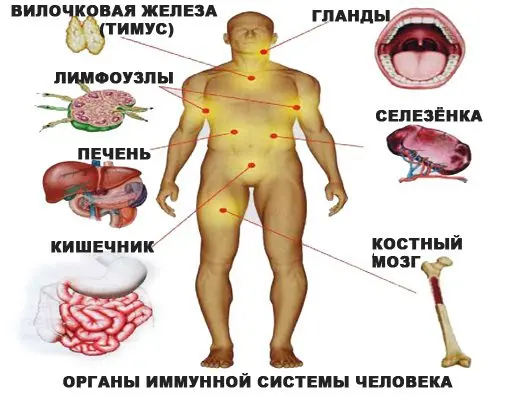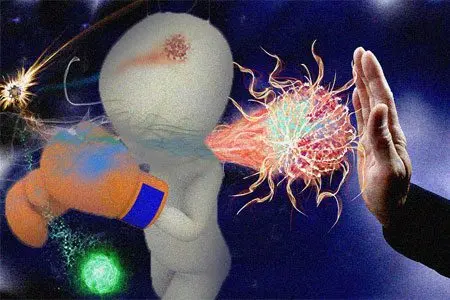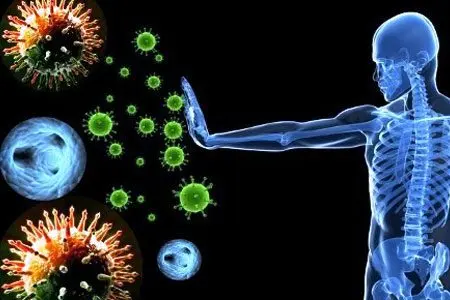Contents
What is the immune system?
The immune system is a set of organs, tissues and cells, the work of which is aimed directly at protecting the body from various diseases and at the extermination of foreign substances that have already entered the body.
It is this system that is an obstacle to infectious agents (bacterial, viral, fungal). When the immune system fails, the likelihood of developing infections increases, this also leads to the emergence of autoimmune diseases, including multiple sclerosis.
Organs of the human immune system
Organs included in the human immune system: lymph glands (nodes), tonsils, thymus gland (thymus), bone marrow, spleen and intestinal lymphoid formations (Peyer’s patches). They are united by a complex circulation system, which consists of ducts connecting the lymph nodes.

Lymph node – This is a formation from soft tissues, which has an oval shape, a size of 0,2 – 1,0 cm and contains a large number of lymphocytes.
Tonsils – These are small accumulations of lymphoid tissue located on both sides of the pharynx.
Spleen – an organ that looks very similar to a large lymph node. The functions of the spleen are diverse: it is both a filter for blood, and a storage for its cells, and a place for the production of lymphocytes. It is in the spleen that old and defective blood cells are destroyed. This organ of the immune system is located in the abdomen under the left hypochondrium near the stomach.
Thymus gland (thymus) located behind the chest. Lymphoid cells in the thymus proliferate and “learn”. In children and young people, the thymus is active, the older the person, the more passive and smaller this organ becomes.
Bone marrow – This is a soft spongy tissue located inside the tubular and flat bones. The main task of the bone marrow is the production of blood cells: leukocytes, erythrocytes, platelets.
Peyer’s patches these are concentrations of lymphoid tissue in the walls of the intestine, more specifically, in the appendix (vermiform appendix). However, the main role is played by the circulatory system, consisting of ducts that connect the lymph nodes and transport lymph.
Lymph fluid (lymph) – This is a colorless liquid that flows through the lymphatic vessels, it contains a lot of lymphocytes – white blood cells involved in protecting the body from diseases.
Lymphocytes – these are, figuratively speaking, the “soldiers” of the immune system, they are responsible for the destruction of foreign organisms or their own diseased cells (infected, tumor, etc.). The most important types of lymphocytes are B-lymphocytes and T-lymphocytes. They work together with other immune cells and do not allow foreign substances (infectious agents, foreign proteins, etc.) to invade the body. At the first stage of development of the human immune system, the body “teaches” T-lymphocytes to distinguish foreign proteins from normal (own) proteins of the body. This learning process takes place in the thymus gland in early childhood, as the thymus is most active at this age. When a child reaches puberty, his thymus decreases in size and loses its activity.
An interesting fact: in many autoimmune diseases, for example, in multiple sclerosis, the patient’s immune system “does not recognize” the healthy tissues of his own body, treats them as foreign cells, begins to attack and destroy them.
The role of the human immune system
The immune system appeared along with multicellular organisms and developed as an assistant to their survival. It unites organs and tissues that guarantee the protection of the body from genetically alien cells and substances coming from the environment. In terms of organization and mechanisms of functioning, immunity is similar to the nervous system.
Both of these systems are represented by central and peripheral organs capable of responding to different signals, have a large number of receptor structures and specific memory.
The central organs of the immune system include the red bone marrow, thymus, and the peripheral organs include the lymph nodes, spleen, tonsils, and appendix.
The leading place among the cells of the immune system is occupied by leukocytes. With their help, the body is able to provide various forms of immune response upon contact with foreign bodies, for example, the formation of specific antibodies.
History of Immunity Research
The very concept of “immunity” was introduced into modern science by the Russian scientist I.I. Mechnikov and the German physician P. Ehrlich, who studied the protective reactions of the body in the fight against various diseases, primarily infectious ones. Their joint work in this area was even awarded the Nobel Prize in 1908. A great contribution to the science of immunology was also made by the work of the French scientist Louis Pasteur, who developed a method of vaccination against a number of dangerous infections.
The word “immunity” comes from the Latin “immunis”, which means “pure from something.” Initially, it was believed that the immune system protects us only from infectious diseases. However, the studies of the English scientist P. Medawar in the middle of the twentieth century proved that immunity provides protection in general from any alien and harmful interference in the human body.
Currently, immunity is understood, firstly, as resistance to infections, and secondly, as the body’s responses aimed at destroying and removing from it everything that is alien and threatening to it. It is clear that if people did not have immunity, they simply could not exist, and it is precisely its presence that makes it possible to successfully fight diseases and live to old age.
The work of the immune system

The immune system has been formed over many years of human evolution and operates as a well-oiled mechanism. It helps us fight disease and harmful environmental influences. The tasks of immunity include recognizing, destroying and bringing out both foreign agents penetrating from the outside and decay products formed in the body itself (during infectious and inflammatory processes), as well as exterminating pathologically changed cells.
The immune system is able to recognize many “aliens”. Among them are viruses, bacteria, poisonous substances of plant or animal origin, protozoa, fungi, allergens. Among the enemies, she also includes those that have turned into cancer cells, and therefore their own cells that have become dangerous. The main goal of immunity is to provide protection against intrusions and preserve the integrity of the internal environment of the body, its biological individuality.
How is the recognition of “outsiders”? This process takes place at the genetic level. The fact is that each cell carries its own genetic information inherent only to this particular organism (you can call it a label). It is her immune system that analyzes when it detects penetration into the body or changes in it. If the information matches (the label is present), then it’s your own, if it doesn’t match (the label is missing), then it’s someone else’s.
In immunology, foreign agents are called antigens. When the immune system detects them, defense mechanisms immediately turn on, and a fight begins against the “stranger”. Moreover, to destroy each specific antigen, the body produces specific cells, they are called antibodies. They fit antigens like a key to a lock. Antibodies bind to the antigen and eliminate it, so the body fights the disease.
Allergic reactions

Allergy is one of the main human immune reactions – a state of increased body response to allergens. Allergens are substances that contribute to the occurrence of the corresponding reaction. Allocate internal and external factors provocateurs of allergies.
External allergens include certain foods (eggs, chocolate, citrus fruits), various chemicals (perfumes, deodorants), and drugs.
Internal allergens – own cells, usually with altered properties. For example, during burns, the body perceives dead tissues as foreign, and creates antibodies for them. The same reactions can occur with the stings of bees, bumblebees and other insects.
Allergies develop rapidly or sequentially. When an allergen acts on the body for the first time, the immune system produces and accumulates antibodies with increased sensitivity to it. When the same allergen enters the body again, an allergic reaction occurs, for example, skin rashes, swelling, redness and itching appear.
Is there a “superimmunity”?

There are people who convince that there is super-immunity, and this phenomenon is not so rare. But they cannot give an answer to the question that arises: why hasn’t nature still naturally created a super-powerful system that would not be affected by any pathogenic microorganism? In fact, the answer is obvious: extra strong immunity will become a threat to the human body. Any distortion of this complex multi-component living system threatens to disrupt the functioning of vital organs. Here are just a few examples:
An allergic reaction is a consequence of a particularly active immune system to proteins that are absolutely normal for the rest. The result is allergic asthma or eczema.
The “cytokine cascade” is a potentially lethal reaction. Its inflammatory reaction is so powerful that the mass of cytokines produced uncontrollably by the body leads to the development of multiple organ failure, as a result of which the patient may die. Hypercytokinemia is one of the causes of deaths during an influenza pandemic.
Autoimmune disease occurs when overactive cells of the immune system are toxic to the body. Example: type 1 diabetes, several types of rheumatoid arthritis, etc.
What of the above is meant by those who are promoting “immunity boost”? The above examples prove that raising the level of sensitivity of the immune system, or increasing the amount of substances produced by it in special cases, as well as increasing the number of cells – all this causes great harm to the body.
It is necessary to pay attention to the fact that when the immune system comes into contact with an external attack and reacts with an increase in its cellular balance, then, as soon as the “victory” comes, the body is diligently cleansed of the excess “ballast” of protective cells – they collapse in the process of programmed destruction – apoptosis.
Therefore, scientists do not have arguments for the existence of a hyperstrong immune system. If we consider immunity, it becomes clear that “norm” and “pathology” are exactly those concepts that you cannot argue with. And the meaning of the expressions: “strengthen immunity”, “strengthen it”, “improve the state of the immune system” – have no basis and are the result of high-quality advertising.
Factors that weaken our immune system

At birth, nature “gives” a person an almost ideal and most effective protective system. It is so perfect that it takes a lot of effort to “weaken” it. So what causes a real deterioration in the work of this protective mechanism, or a decrease in immunity?
Prolonged severe stress (for example, the sudden loss of a loved one, the threat of an incurable disease, war), hunger and food shortages, Stable lack of important microelements and vitamins by the body. If these conditions are observed for months or even years, then they really affect the decrease in the protective segments of the immune system.
Some chronic diseases affect the undermining of the protective function. These include diabetes.
Congenital and acquired immunodeficiencies (AIDS), as well as procedures that deliberately depress the immune system: chemotherapy, immunosuppressive therapy.
Advanced age. Elderly people experience a drop in the work of all systems, including the immune system. For example, the number of T-lymphocytes produced in response to infection in the body decreases markedly over the years. As a result, disease resistance decreases.
It should be noted that “traditional” infections – flu, colds and others – are not afraid of the immune system. The kind of painful conditions that people experience when they get the flu periodically are just part of the immune system’s response. It’s not her downfall.
[Video] Dr. Berg – 5 main factors that reduce immunity:









